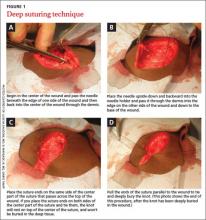Avoid dog ears. Dog ears (bunching of skin at one end of a wound closure) usually are the result of unequal amounts of opposing tissue. Causes range from ragged lacerations and flap procedures to uneven apportion of tissue when suturing.
If the difference in the lengths of the 2 sides of a wound is ≤15%, the halving technique (placing the first suture in the center of the wound, the next suture in the center of each remaining segment, and so on) works well to avoid dog ears. Otherwise, a Burow triangle repair—a procedure that slightly extends the wound but removes the excess tissue and results in a better cosmetic outcome—may be required.
If while in the process of repairing a relatively small wound you notice that dog ears occur as the result of poor technique, consider removing and redoing the sutures.
Deep suturing reduces tension, improves outcomes
To achieve the best possible cosmetic outcomes when closing a particularly deep wound, consider placing deep sutures. Because scars remodel for about a year post-repair, tension across the wound area may produce a wider and more unsightly scar as time goes by. Deep closure of a wound with dissolvable sutures can:15
• reduce or eliminate wound tension when suturing the epidermis
• close potential space below the skin
• stop subcutaneous bleeding
• reduce hematoma and seroma formation.
The technique for deep suture placement is shown in FIGURES 1A to 1D. The decreased tension in the healing scar that results from placing deep-buried sutures will reduce the final width of the scar. Buried dermal sutures do not increase the risk of infection in clean, uncontaminated lacerations. However, animal studies suggest that deep sutures should be avoided in highly contaminated wounds.16
For deep lacerations with potential space remaining, use vertical mattress sutures to approximate the wound edges.15 The vertical mattress suture technique is shown in FIGURES 2A to 2C. This technique incorporates a large amount of tissue within the passage of the suture loops and provides good tensile strength in closing wound edges over a distance or under tension. It also is used for wounds in locations where wound edges tend to invert, such as on the posterior neck, behind the ear, in the groin, in the inframammary crease, or on concave body surfaces. Early removal (half of the generally recommended days) of vertical mattress sutures can help prevent suture marks, especially if nearby simple interrupted sutures can remain in place for the recommended duration.
When to consider tape, staples, or adhesive
Don’t overlook wound closure tapes for superficial wounds. Even if tape is a poor candidate for the primary wound closure, it still may be used during the early stages of wound healing to support other closures by spreading tension over a larger area than just the suture area. Apply one strip at a time on one side of the wound, then pull the tape across, everting the edges of the wound. This can help eliminate the “railroad track” scars sometimes caused by tight sutures.
Often, the tip of a triangular flap will refuse to nudge up to the corner, even with a well-placed corner suture. Tape applied and then pulled over the tip can help approximate the tissue for this type of wound. An alternative use of tape is to strengthen fragile skin to allow for suturing. The tape can be applied to either side of a wound and the suture needle can be driven though the tape and skin so you can close as usual. To improve adhesion, use tincture of benzoin over the areas on which you want to apply tape.
When using staples for closure, be certain to approximate the tissue carefully. When possible, have an assistant approximate the edges. Hold the stapler with the center mark at the middle of the skin edges. Squeeze the handle completely while keeping the stapler still during application. Properly applied staples are much less painful to remove, which your patients will appreciate.
Using tissue adhesives can save time because the procedure is quick and does not require suture or staple removal. Clean, low-tension wounds on the face tend to do well with adhesives. When on the fence about whether to suture or use adhesive, choose suture. Any wound for which you would consider using adhesive should be small enough to suture in just a few minutes.



